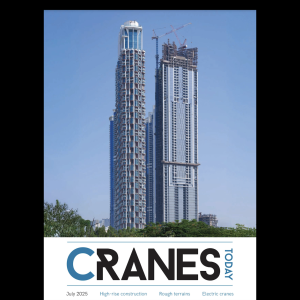500km inside the Arctic Circle, Novatek’s $25.5bn Arctic 2 LNG will be at the forefront of satisfying Russia’s domestic and export energy market when completed in 2023. Situated on Siberia’s Gyda Peninsula, the region is remote, inhospitable, and very cold – winter temperatures average just -30°C and it’s dark from mid-November until late February.
MRTS, part of a team of specialist contractors assembled by Novatek with experience of working in Russia’s Arctic Region, has been tasked with delivering a series of pipelines, quays, and wharfs to facilitate operation of the Arctic 2 LNG.
In preparation for the work, MRTS acquired the two CKS2500 crawler cranes from Kobelco Cranes’ Russian dealer, FKR Machinery. Before being able to start work, however, both machines needed some modification.
“Kobelco Cranes can work almost anywhere,” said Rene Kraakman, Kobelco Cranes’ service and technical support manager, “but the Arctic is a special type of environment, that requires something completely different from man and machine.
“Normally we supply our cranes with ISO VG32 oils for the Russian market, which are suitable for operating temperatures of +30°C to -25°C,” says Rene, “but for the extreme cold found in Siberia, FKR used Kobelco’s ISO VG22 oil, which is suitable for temperatures from +15°C to -30 °C, and retrofitted both machines with Webasto’s Arctic Kit, which allows the machine to work in this extremely hostile environment.”
To cope with the extremely low temperatures in the Arctic, the Webasto kit includes: Air heaters that operate independently of the engine, allowing the operator to maintain interior temperatures without idling the machine; coolant heaters that bring the engine to optimum operating temperature with the option to heat the cab and hydraulic fluids, even before starting the workday; integrated heat exchangers, available in various capacities, allow for multiple configurations and installation positions, and can be paired with a fuel operated heater.
To complete pipe laying and foundation works, each crane is mounted on one of MRTS’s two ocean-going vessels – the 135m x 40m, 13,515t Deck Cargo Pontoon, MRTS Defender, and the 169m ? 46m, 40,978t Pipelay Crane Vessel, PLB Fortuna.
MRTS Defender is a ten-point anchor barge designed to lay underwater pipelines of 152mm to 1520mm in diameter to depths of up to 150m using the CKS2500 and six, 75t capacity davit cranes, while PLB Fortuna is a 12-point anchor barge used to lay underwater pipelines of 100mm to 1520mm in diameter and is fitted with six davit cranes with lifting capacities of 70t to 90t, and a 1,600t capacity pedestal crane.
To complement the work of the barges, the two CKS2500s are both and fitted with a CR67.1m boom with free fall winches with boom lengths of 51.8m and 57.9m respectively for a working radius of 20m. Pile weights for the quays and wharf construction can up to 30t, with a maximum length of 45m, while concrete pipes used for the delivery of the gas can be as large as 1,000mm in diameter and 10m in length, with a maximum weight of 20t.






